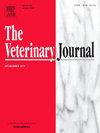a架与前跳距离的改变对敏捷犬前肢动力学的影响
IF 3.1
2区 农林科学
Q1 VETERINARY SCIENCES
引用次数: 0
摘要
与障碍相关的敏捷性损伤的高比例是由于A型框架,然而,对狗穿越这种类型设备的动力学和运动学的研究有限。本研究的目的是研究当前面的障碍(在这种情况下是跳跃)被放置在a框架前10 米,7.5 米和5 米时,敏捷犬通过a框架的运动学和动力学。记录了6只比赛标准敏捷犬在完成跳跃后的a型框架,每只狗在每段距离尝试三次。附着在每只狗身上的惯性测量装置收集了从跳跃着陆到a型架之间的最大速度、加速度和减速度。视频分析和压力传感器收集了狗与a型框架接触时两只前肢的腕关节超伸和峰值垂直力。研究发现,不同距离的腕关节伸展和PVF数据没有差异。然而,最大的方法速度降低(p & lt; 0.05)减少距离:10 米(7.30 ±0.40 m / s), 7 m(6.61 ±0.34 m / s),和5 m(5.74 ±0.62 m / s)。距离5 m时,加速度也比距离10 m时减小(p <; 0.05)。值得注意的发现是−1.57 m / s2下降减速之间发现10 米(-5.92 m / s2)和5 m(-4.35 m / s2)的距离(p & lt; 0.05),10 米距离有36 %比5 m减速。由于前肢在减速中起作用,障碍物之间的距离增加可能是敏捷犬前肢损伤的因素之一。在我们的研究中,将前面的障碍物放置在距离a型框架5 m处,可以调节速度、加速和减速,并可能有助于减少报道的受伤率,但建议进行更多的研究,以提供基于证据的指导。本文章由计算机程序翻译,如有差异,请以英文原文为准。
The effects of altered distances between A-frame and the preceding jump on front limb dynamics in agility dogs
A high proportion of agility injuries associated with an obstacle are due to the A-frame, however, there is limited research into the kinetics and kinematics of dogs traversing this type of equipment. The aim of this research was to study the kinematics and kinetics of agility dogs negotiating an A-frame when the preceding obstacle (in this case a jump) was placed at 10 m, 7.5 m and 5 m ahead of the A-frame. Six competition standard agility dogs were recorded negotiating an A-frame after completing a jump with each dog attempting each distance three times. Inertial measuring units attached to each dog gathered maximum velocity, acceleration and deceleration between jump landing and the A-frame. Video analysis and pressure sensors gathered carpal hyperextension and peak vertical forces for both forelimbs at the dogs’ contact with the A-frame. The study found no difference in either carpal extension or PVF data between the different distances. However, maximum approach velocity decreased (p < 0.05) with decreasing distance: 10 m (7.30 ± 0.40 m/s), 7 m (6.61 ± 0.34 m/s), and 5 m (5.74 ± 0.62 m/s). Acceleration was also decreased at the 5 m distance compared with 10 m distance (p < 0.05). A notable finding was the −1.57 m/s2 decrease in deceleration found between the 10 m (-5.92 m/s2) and 5 m (-4.35 m/s2) distances (p < 0.05), with the 10 m distance having 36 % more deceleration than 5 m. As forelimbs have a role in deceleration, an increased distance between obstacles could be one of the factors involved in forelimbs injuries in agility dogs. In our study, positioning the preceding obstacle 5 m from the A-frame moderated speed, acceleration, and deceleration, and could potentially help to reduce reported injury rates, but additional studies are recommended to allow evidence-based guidelines.
求助全文
通过发布文献求助,成功后即可免费获取论文全文。
去求助
来源期刊

Veterinary journal
农林科学-兽医学
CiteScore
4.10
自引率
4.50%
发文量
79
审稿时长
40 days
期刊介绍:
The Veterinary Journal (established 1875) publishes worldwide contributions on all aspects of veterinary science and its related subjects. It provides regular book reviews and a short communications section. The journal regularly commissions topical reviews and commentaries on features of major importance. Research areas include infectious diseases, applied biochemistry, parasitology, endocrinology, microbiology, immunology, pathology, pharmacology, physiology, molecular biology, immunogenetics, surgery, ophthalmology, dermatology and oncology.
 求助内容:
求助内容: 应助结果提醒方式:
应助结果提醒方式:


